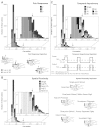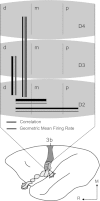Effects of spatiotemporal stimulus properties on spike timing correlations in owl monkey primary somatosensory cortex
- PMID: 23019003
- PMCID: PMC3544888
- DOI: 10.1152/jn.00414.2011
Effects of spatiotemporal stimulus properties on spike timing correlations in owl monkey primary somatosensory cortex
Abstract
The correlated discharges of cortical neurons in primary somatosensory cortex are a potential source of information about somatosensory stimuli. One aspect of neuronal correlations that has not been well studied is how the spatiotemporal properties of tactile stimuli affect the presence and magnitude of correlations. We presented single- and dual-point stimuli with varying spatiotemporal relationships to the hands of three anesthetized owl monkeys and recorded neuronal activity from 100-electrode arrays implanted in primary somatosensory cortex. Correlation magnitudes derived from joint peristimulus time histogram (JPSTH) analysis of single neuron pairs were used to determine the level of spike timing correlations under selected spatiotemporal stimulus conditions. Correlated activities between neuron pairs were commonly observed, and the proportions of correlated pairs tended to decrease with distance between the recorded neurons. Distance between stimulus sites also affected correlations. When stimuli were presented simultaneously at two sites, ∼37% of the recorded neuron pairs showed significant correlations when adjacent phalanges were stimulated, and ∼21% of the pairs were significantly correlated when nonadjacent digits were stimulated. Spatial proximity of paired stimuli also increased the average correlation magnitude. Stimulus onset asynchronies in the paired stimuli had small effects on the correlation magnitude. These results show that correlated discharges between neurons at the first level of cortical processing provide information about the relative locations of two stimuli on the hand.
Figures








Similar articles
-
Spatiotemporal properties of neuron response suppression in owl monkey primary somatosensory cortex when stimuli are presented to both hands.J Neurosci. 2011 Mar 9;31(10):3589-601. doi: 10.1523/JNEUROSCI.4310-10.2011. J Neurosci. 2011. PMID: 21389215 Free PMC article.
-
Response properties of neurons in primary somatosensory cortex of owl monkeys reflect widespread spatiotemporal integration.J Neurophysiol. 2010 Apr;103(4):2139-57. doi: 10.1152/jn.00709.2009. Epub 2010 Feb 17. J Neurophysiol. 2010. PMID: 20164400 Free PMC article.
-
Widespread spatial integration in primary somatosensory cortex.Proc Natl Acad Sci U S A. 2008 Jul 22;105(29):10233-7. doi: 10.1073/pnas.0803800105. Epub 2008 Jul 15. Proc Natl Acad Sci U S A. 2008. PMID: 18632579 Free PMC article.
-
Attending to and remembering tactile stimuli: a review of brain imaging data and single-neuron responses.J Clin Neurophysiol. 2000 Nov;17(6):575-91. doi: 10.1097/00004691-200011000-00004. J Clin Neurophysiol. 2000. PMID: 11151976 Review.
-
Importance of spike timing in touch: an analogy with hearing?Curr Opin Neurobiol. 2016 Oct;40:142-149. doi: 10.1016/j.conb.2016.07.013. Epub 2016 Aug 6. Curr Opin Neurobiol. 2016. PMID: 27504741 Free PMC article. Review.
Cited by
-
Chronic recordings reveal tactile stimuli can suppress spontaneous activity of neurons in somatosensory cortex of awake and anesthetized primates.J Neurophysiol. 2016 Apr;115(4):2105-23. doi: 10.1152/jn.00634.2015. Epub 2016 Feb 24. J Neurophysiol. 2016. PMID: 26912593 Free PMC article.
-
Cortical neuron response properties are related to lesion extent and behavioral recovery after sensory loss from spinal cord injury in monkeys.J Neurosci. 2014 Mar 19;34(12):4345-63. doi: 10.1523/JNEUROSCI.4954-13.2014. J Neurosci. 2014. PMID: 24647955 Free PMC article.
-
Connectivity of somatosensory cortical area 1 forms an anatomical substrate for the emergence of multifinger receptive fields and complex feature selectivity in the squirrel monkey (Saimiri sciureus).J Comp Neurol. 2014 Jun 1;522(8):1769-85. doi: 10.1002/cne.23499. J Comp Neurol. 2014. PMID: 24214200 Free PMC article.
-
Correlates of a single cortical action potential in the epidural EEG.Neuroimage. 2015 Apr 1;109:357-67. doi: 10.1016/j.neuroimage.2014.12.057. Epub 2014 Dec 30. Neuroimage. 2015. PMID: 25554430 Free PMC article.
-
Correlated Disruption of Resting-State fMRI, LFP, and Spike Connectivity between Area 3b and S2 following Spinal Cord Injury in Monkeys.J Neurosci. 2017 Nov 15;37(46):11192-11203. doi: 10.1523/JNEUROSCI.2318-17.2017. Epub 2017 Oct 16. J Neurosci. 2017. PMID: 29038239 Free PMC article.
References
-
- Aertsen AMHJ, Gerstein GL, Habib M, Palm G. Dynamics of neuronal firing correlation: modulation of “effective connectivity”. J Neurophysiol 61: 900–917, 1989 - PubMed
-
- Alloway KD, Zhang M, Dick SH, Roy SA. Pervasive synchronization of local neural networks in the secondary somatosensory cortex of cats during focal cutaneous stimulation. Exp Brain Res 147: 227–242, 2002 - PubMed
Publication types
MeSH terms
Grants and funding
LinkOut - more resources
Full Text Sources

